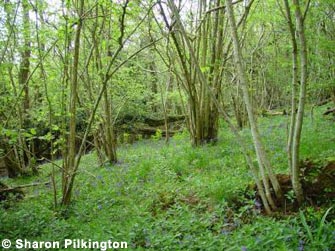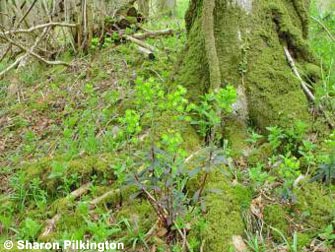
Typical Mendip habitats
Introduction | Unimproved limestone grassland | Acid dwarf-shrub heath | Ash woodland
Ash woodland

Where nature has been able to take its full course, deciduous woodland has developed. Over well-drained calcareous deposits, ash is the main canopy tree, though pedunculate oak often also occurs, particularly where soils are locally leached. Many of these woods have been managed for centuries in the traditional 'coppice with standards' manner, and typically, the well-developed shrub understorey includes frequent hazel coppice stools, some of which may be of considerable age. Field maple and wych elm are often quite frequent associates, the latter occurring as small suckering trees rather than the large standards which used to be abundant before the Dutch Elm disease epidemic in the late twentieth century.

Well-developed ash woodlands can be seen in Cheddar Gorge, Harptree Combe and Long Wood. They typically support a rich and attractive ground flora, and bluebells, ramsons and dog's-mercury are the most obvious species. Many other species flourish in relatively open woodlands, most of them flowering in spring before the tree canopy closes over. Primroses, violets, bugle, wood spurge, woodruff, wood melick and many other indicator species of ancient woodland can all be found, along with more uncommon and characteristic Somerset herbs e.g. herb Paris, Solomon's-seal and toothwort. The high rainfall and clean air of the Mendip Hills also favours ferns, mosses, liverworts, lichens and fungi, and luxuriant carpets of bryophytes are typical of many woodland floors.
- Home
- Overview maps
- Locality
areas
- Cheddar Gorge
- Charterhouse
- Blackdown
- Burrington Combe
- Shipham & Rowberrow
- Crook Peak & Axbridge
- Banwell to Churchill
- Priddy
- Harptree & Smitham Hill
- Draycott & Westbury-sub-Mendip
- Wookey Hole & Ebbor Gorge
- Wells
- Great Elm & Vallis Vale
- Mells & the Wadbury Valley
- The Vobster area
- The Whatley area
- Torr Works & Asham Wood
- Beacon Hill
- Stoke St Michael & Oakhill
- Holwell & Nunney
- Shepton Mallet & Maesbury
- Gurney Slade & Emborough
- The Nettlebridge valley
- Geology
- Minerals and mines
- Quarrying
- Caves and karst
- Biodiversity
- Detailed site information
- Acknowledgements
- External links
- Search
- Site map